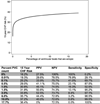Ventricular Ectopy as a Predictor of Heart Failure and Death
- PMID: 26160626
- PMCID: PMC4499114
- DOI: 10.1016/j.jacc.2015.04.062
Ventricular Ectopy as a Predictor of Heart Failure and Death
Abstract
Background: Studies of patients presenting for catheter ablation suggest that premature ventricular contractions (PVCs) are a modifiable risk factor for congestive heart failure (CHF). The relationship among PVC frequency, incident CHF, and mortality in the general population remains unknown.
Objectives: The goal of this study was to determine whether PVC frequency ascertained using a 24-h Holter monitor is a predictor of a decrease in the left ventricular ejection fraction (LVEF), incident CHF, and death in a population-based cohort.
Methods: We studied 1,139 Cardiovascular Health Study (CHS) participants who were randomly assigned to 24-h ambulatory electrocardiography (Holter) monitoring and who had a normal LVEF and no history of CHF. PVC frequency was quantified using Holter studies, and LVEF was measured from baseline and 5-year echocardiograms. Participants were followed for incident CHF and death.
Results: Those in the upper quartile versus the lowest quartile of PVC frequency had a multivariable-adjusted, 3-fold greater odds of a 5-year decrease in LVEF (odds ratio [OR]: 3.10; 95% confidence interval [CI]: 1.42 to 6.77; p = 0.005), a 48% increased risk of incident CHF (HR: 1.48; 95% CI: 1.08 to 2.04; p = 0.02), and a 31% increased risk of death (HR: 1.31; 95% CI: 1.06 to 1.63; p = 0.01) during a median follow-up of >13 years. Similar statistically significant results were observed for PVCs analyzed as a continuous variable. The specificity for the 15-year risk of CHF exceeded 90% when PVCs included at least 0.7% of ventricular beats. The population-level risk for incident CHF attributed to PVCs was 8.1% (95% CI: 1.2% to 14.9%).
Conclusions: In a population-based sample, a higher frequency of PVCs was associated with a decrease in LVEF, an increase in incident CHF, and increased mortality. Because of the capacity to prevent PVCs through medical or ablation therapy, PVCs may represent a modifiable risk factor for CHF and death.
Keywords: arrhythmia; mortality; premature ventricular contractions.
Copyright © 2015 American College of Cardiology Foundation. Published by Elsevier Inc. All rights reserved.
Figures




Comment in
-
Abnormal extra heartbeats may be modifiable risk factor for heart failure, study shows.BMJ. 2015 Jul 7;351:h3674. doi: 10.1136/bmj.h3674. BMJ. 2015. PMID: 26157080 No abstract available.
-
Ventricular Ectopy as a Modifiable Risk Factor for Heart Failure and Death: "Déjà Vu All Over Again" May Be a Good Thing.J Am Coll Cardiol. 2015 Jul 14;66(2):110-2. doi: 10.1016/j.jacc.2015.05.031. J Am Coll Cardiol. 2015. PMID: 26160627 No abstract available.
References
-
- Evenson KR, Welch VL, Cascio WE, et al. Validation of a short rhythm strip compared to ambulatory ECG monitoring for ventricular ectopy. J Clin Epidemiol. 2000;53:491–497. - PubMed
-
- Poblete PF, Kennedy HL, Caralis DG. Detection of ventricular ectopy in patients with coronary heart disease and normal subjects by exercise testing and ambulatory electrocardiography. Chest. 1978;74:402–407. - PubMed
-
- Codd MB, Sugrue DD, Gersh BJ, et al. Epidemiology of idiopathic dilated and hypertrophic cardiomyopathy. A population-based study in Olmsted County, Minnesota, 1975–1984. Circulation. 1989;80:564–572. - PubMed
-
- Felker GM, Thompson RE, Hare JM, et al. Underlying causes and long-term survival in patients with initially unexplained cardiomyopathy. N Engl J Med. 2000;342:1077–1084. - PubMed
-
- Fried LP, Borhani NO, Enright P, et al. The Cardiovascular Health Study: design and rationale. Ann Epidemiol. 1991;1:263–276. - PubMed
MeSH terms
Grants and funding
- N01 HC085080/HL/NHLBI NIH HHS/United States
- U01 HL080295/HL/NHLBI NIH HHS/United States
- N01 HC085082/HL/NHLBI NIH HHS/United States
- HHSN268201200036C/HL/NHLBI NIH HHS/United States
- N01 HC055222/HL/NHLBI NIH HHS/United States
- N01 HC085079/HL/NHLBI NIH HHS/United States
- R01 HL080295/HL/NHLBI NIH HHS/United States
- R01 AG023629/AG/NIA NIH HHS/United States
- R56 AG023629/AG/NIA NIH HHS/United States
- HHSN268200800007C/HL/NHLBI NIH HHS/United States
- N01 HC085086/HL/NHLBI NIH HHS/United States
- N01 HC085083/HL/NHLBI NIH HHS/United States
- N01 HC085081/HL/NHLBI NIH HHS/United States
- R01 HL116747/HL/NHLBI NIH HHS/United States
LinkOut - more resources
Full Text Sources
Other Literature Sources
Medical

